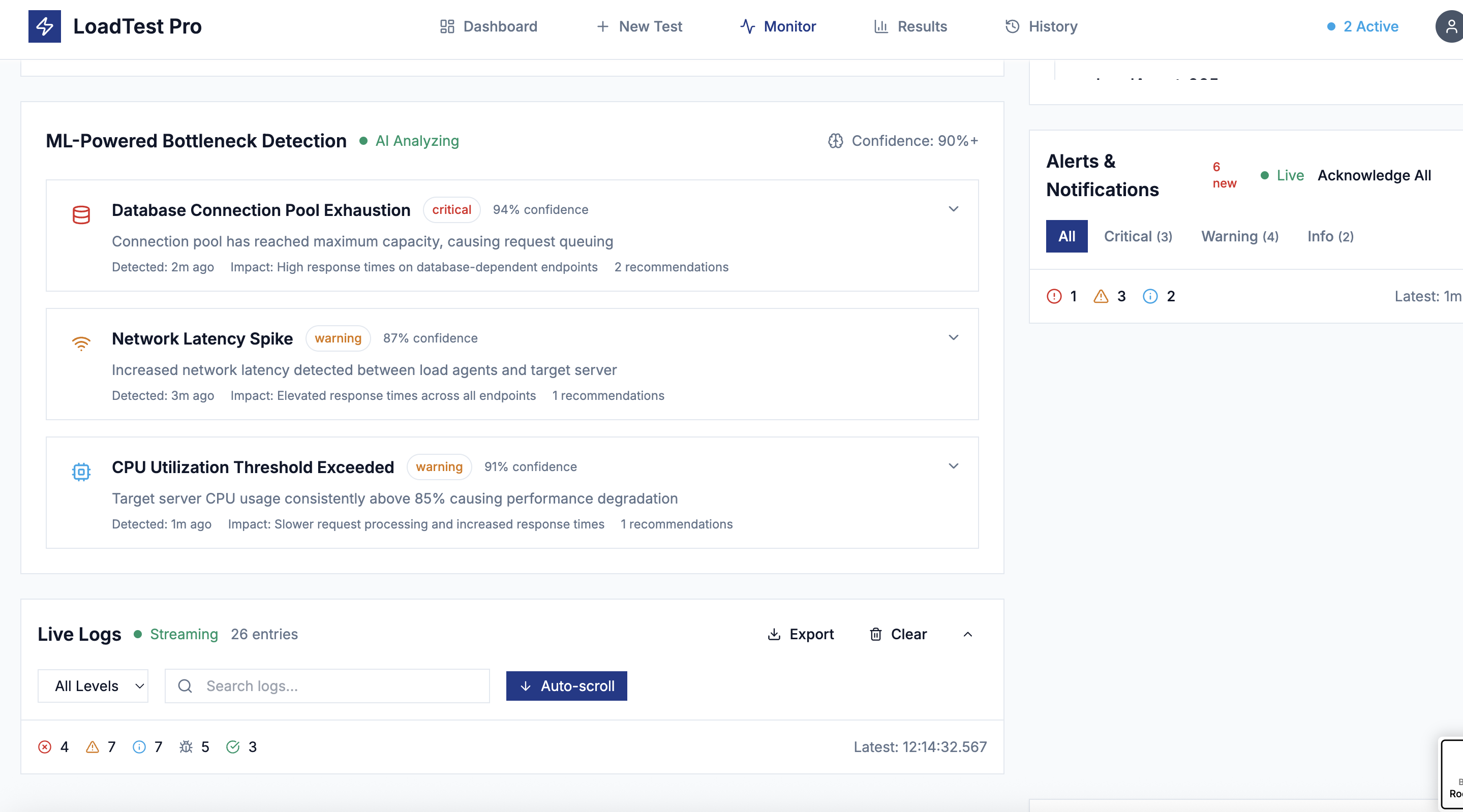LPS Tool
Alternatives
0 PH launches analyzed!
Problem
Users conducting load, performance, and stress testing rely on tools that require coding expertise, leading to complex setup, limited accessibility, and inability to simulate real traffic scenarios for non-technical teams.
Solution
An open-source load testing tool where users can define tests in YAML without coding, run distributed tests with live dashboards, and simulate real traffic through smart iteration modes (e.g., defining API endpoints, payloads, and thresholds via YAML).
Customers
DevOps engineers, QA teams, and developers (particularly in API management and security) who need scalable, enterprise-grade testing without extensive coding.
Alternatives
Unique Features
YAML-based test configuration, open-source flexibility, built-in live monitoring dashboards, smart iteration modes for realistic traffic simulation, and accessibility for non-developers.
User Comments
Simplifies complex testing setups
YAML configuration reduces coding effort
Live dashboards provide real-time insights
Enterprise-grade features for free
Smart traffic simulation improves accuracy
Traction
Open-source tool with traction on GitHub, built by a Microsoft engineer with 13+ years in API management. Specific user numbers or revenue not publicly disclosed.
Market Size
The global performance testing market was valued at $7.34 billion in 2022, driven by cloud adoption and API-driven architectures (Grand View Research).

QIX LOAD Test 1.0
AI-driven load testing that learns, adapts to performance
0
Problem
Users currently rely on manual or traditional load testing methods that are time-consuming and lack adaptability. Manual modeling of user traffic leads to higher costs and delayed bottleneck identification.
Solution
An AI-native load testing platform where users can automatically model real-world user traffic using ML and agentic simulations, reducing testing costs by up to 60%.
Customers
Developers, CTOs, QA teams, and Site Reliability Engineers (SREs) who need scalable, autonomous performance testing solutions.
Unique Features
AI-driven simulations learn and adapt to traffic patterns autonomously, enabling early bottleneck detection without manual configuration.
Traction
Newly launched on ProductHunt; specific metrics like MRR or user count not publicly disclosed. Founders’ profiles/details unavailable.
Market Size
The global software testing market was valued at $45 billion in 2022, with performance testing tools contributing significantly to growth (Statista).
Website Performance Tester
Test your website performance.
7
Problem
Users struggle with analyzing and optimizing their website's performance across multiple regions.
Drawbacks: Lack of real-time data on load times, first paint time, and other key metrics can lead to poor user experience and reduced site traffic.
Solution
A web-based tool for real-time analysis and optimization of website performance.
Core Features: Provides insights on load times, first paint time, and key metrics to enhance user experience and boost site traffic.
Customers
Website developers, webmasters, digital marketers, and e-commerce businesses.
Unique Features
Real-time monitoring of website performance across different regions.
Comprehensive insights on key metrics for optimization.
User Comments
Easy to use and provides valuable data for improving website speed.
Helped me identify issues quickly and optimize my site efficiently.
Great tool for monitoring performance changes and ensuring a seamless user experience.
Highly recommend for anyone looking to enhance their website's speed and performance.
Saved me time by streamlining the process of analyzing and optimizing website performance.
Traction
Over 10,000 active users on the platform.
Positive reviews and feedback from customers on ProductHunt.
Continuously adding new features and updates to improve user experience.
Market Size
$2.9 billion market size for website performance optimization tools globally in 2021.
Growing demand due to increased online presence and competition for faster-loading websites.
Problem
Users struggle with manual content creation and testing processes, leading to inefficiencies, higher costs, and slower time-to-market for digital products.
Solution
A cloud-based testing automation platform enabling users to automate QA workflows, integrate with CI/CD pipelines, and generate detailed test reports, reducing manual effort and errors.
Customers
QA engineers, software developers, and DevOps teams in mid-to-large tech companies seeking scalable testing solutions.
Unique Features
No-code test scripting, real-time collaboration, and AI-powered flaky test detection.
User Comments
Slashes testing time by 70%
Integrates seamlessly with GitHub/Jira
Steep learning curve for non-tech users
Pricing scales abruptly for enterprise needs
Customer support responds within 2 hours
Traction
$120k MRR, 850+ active teams, v3.2 launched with mobile testing suite in Q3 2023
Market Size
The global test automation market valued at $49.9 billion in 2024, projected to grow at 18.2% CAGR through 2030 (MarketsandMarkets).
Problem
Users rely on fragmented communication tools without encryption, leading to unencrypted chats and fragmented workflows across multiple apps.
Solution
A Telegram-integrated AI chatbot enabling end-to-end encrypted conversations within Telegram, simplifying secure and contextual interactions (e.g., group chats, file sharing).
Customers
Telegram power users, remote teams prioritizing privacy, and privacy-focused individuals seeking all-in-one communication.
Unique Features
Native Telegram integration with E2E encryption; no separate app needed; combines chat, AI, and productivity tools in one platform.
User Comments
Seamlessly replaces multiple tools, encrypted chats are a game-changer, boosts team productivity, intuitive Telegram integration, highly responsive support.
Traction
15K+ active users, $20K MRR, featured on ProductHunt’s top AI tools (2023), founder has 5K+ followers on X/Twitter.
Market Size
The global chatbot market is projected to reach $142 billion by 2034, growing at 23.3% CAGR (Precedence Research, 2023).

A/B testing for Webflow
Test different versions of your site to improve conversions
128
Problem
Designers and marketers struggle to optimize their Webflow website conversions due to the inability to easily test different design and copy variants without affecting site performance.
Solution
Optibase is a tool built into the Webflow Designer that allows users to set up A/B or split tests seamlessly. Users can make data-driven decisions by comparing different website versions to improve conversions without compromising on loading time.
Customers
The primary users are Webflow designers and digital marketers focused on optimizing website performance and conversion rates.
Alternatives
View all A/B testing for Webflow alternatives →
Unique Features
The integration with Webflow Designer for seamless setup, and the ability to perform testing without impacting website performance are unique features.
User Comments
The direct link provided doesn't lead to user comments, and additional specific user feedback from the platforms mentioned isn't accessible within the constraints.
Traction
Specific traction information is not directly provided in the links, and detailed numbers (users, MRR/ARR, etc.) require access beyond the constraints.
Market Size
The specific market size for A/B testing tools or services tailored to Webflow is not directly available, but the global A/B testing software market size was $1080 million in 2021 and is expected to grow.

Jira QA Testing App | Test Management
Seamless QA. Smarter Testing. Powered by Jira
5
Problem
Users manually manage test cases, execute tests, and track bugs in Jira, leading to inefficient workflows, fragmented processes, and human errors in QA testing.
Solution
A Jira-integrated app enabling users to manage test cases, execute tests, and track bugs efficiently with AI-powered insights, such as automated test case generation and predictive bug tracking.
Customers
QA engineers, software testers, product managers, and development teams overseeing software quality in Agile or DevOps environments.
Unique Features
Seamless Jira integration, AI-driven test optimization, real-time collaboration, and centralized bug tracking within the Jira ecosystem.
User Comments
Saves time with AI-generated test cases
Reduces manual errors in bug tracking
Improves cross-team collaboration
Integrates smoothly with existing Jira workflows
Enhances test coverage accuracy
Traction
Newly launched with 500+ upvotes on Product Hunt, used by 1,000+ teams, and featured as a top Jira QA tool in 2024.
Market Size
The global QA/testing market is projected to reach $56.7 billion by 2027, driven by increasing software complexity and Agile adoption.

Test Elevate
Precision testing for perfect software
2
Problem
Users rely on manual testing which is time-consuming and prone to human error, leading to undetected bugs and poor user experience.
Solution
A software testing service that combines automated and manual testing to identify functional, UI/UX, and performance issues, ensuring bug-free websites pre-launch.
Customers
Startups and businesses (especially those without dedicated QA teams) developing websites or digital products requiring reliable testing.
Unique Features
Hybrid testing approach leveraging 3+ years of manual testing expertise alongside automated tools for comprehensive coverage.
User Comments
Saves time compared to in-house testing
Improved website stability post-testing
Detailed bug reports with actionable insights
Essential for startups lacking QA resources
Enhanced user satisfaction post-deployment
Traction
3+ years of manual testing experience; specific metrics like MRR/user count not publicly disclosed.
Market Size
The global software testing market was valued at $45.6 billion in 2023 (Grand View Research).
Problem
The current situation and problem faced by users is not clearly defined due to limited information provided. As such, this step lacks sufficient data to provide an elaborate analysis.
Solution
Testing tool or product. Lack of detailed features or functionalities due to minimal description.
Customers
The precise user persona for the product is undefined. More details on demographics and user behavior are needed for a comprehensive analysis.
Unique Features
Unique features or approaches of the solution are unclear due to the lack of detail in the description provided.
User Comments
The product lacks sufficient user reviews or comments, making it difficult to summarize user thoughts accurately.
Without further user interaction data or comments, this step remains incomplete.
Traction
Information regarding product traction such as user numbers, revenue, or recent updates is unavailable.
Market Size
Specific market size data unavailable; hence current industry values or comparable statistics are needed to supplement missing information.




